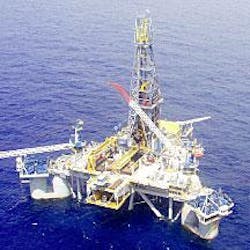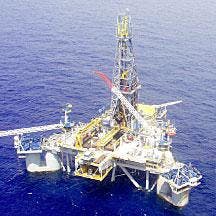Subsea/Surface Systems
Noble applies new station-keeping system
The Noble Amos Runner has installed a station-keeping system that automatically adjusts the heading of the vessel and keeps it on station. The system includes a global positioning system (GPS) receiver, beacon receiver, and new HYDROpro software from a company called Trimble. The GPS and software actively adjust the heading of the rig when it is hit by loop or eddy currents while keeping it on station.
"Trimble's GPS system allows the Noble Amos Runner to keep operating in the Gulf of Mexico when other drilling contractors are shut down," said Mike Briggs, drilling supervisor at Noble. "The system has done a great job in helping keep our rig on location and operating."
The system provides a graphical and numerical display, in real time, of rig position and attitude in relation to fixed seabed locations, such as wellheads, at differential GPS (DGPS) accuracy. The system records information for the historical analysis of rig movements relative to a fixed seabed target. This data is linked to the manual input of environmental and weather conditions.
The dual-antennae MS860 GPS receiver determines accurate heading information (0.03° on a 10-m baseline) and either a submeter differential or centimeter real-time kinematic position. For DGPS accuracy, Noble uses differential corrections from the US Coast Guard's minimum shift keying (MSK) beacons, which are received through the Trimble beacon receivers. MSK is a spectrally efficient form of digital modulation.
The HYDROpro software allows the operator to view the vessel image at the target location and to use map or bull's-eye displays for precise guidance. Once the vessel is in position, the software generates final positioning reports with real-time statistics. HYDROpro is also used to print text reports and export the data to a spreadsheet for further analysis.
FMC tapped for Alpha North subsea system
FMC Energy Systems has been awarded a contract to provide a complete subsea production system for a Statoil project in the North Sea. The system, to be provided by FMC Kongsberg Subsea AS, is for Alpha North, a satellite to the Sleipner West field in the North Sea. Alpha North is being developed by Statoil and its partners. The satellite is expected to begin producing gas and condensate in October 2004. The contract, valued at $23 million, includes options for further work, and FMC Kongsberg Subsea also has won the job of providing technical services and operations support for the production system.
Leak detection at 2,000 m
A new acoustic leak detector (ALD) configuration has been tested in the Black Sea at a depth of 2,000 m. The ALD system was designed for 2,500-m depth and can be installed on an ROV using a standard video channel, fibre optic, or electric connection, for data transmission and 24 Vdc for power. This detector can locate very small leaks in extremely hard environmental conditions.
The system is based on the detection and processing of acoustic signal, which unlike the optical systems, does not suffer from current, poor visibility, or mud suspension in the water. The device works under the premise that a pipeline leakage consists of the transition of a fluid from the higher inside pressure of the pipeline to the lower external pressure. This movement of fluid creates an acoustic signal because of the turbulence and the sudden expansion of the fluid mass. The ALD extracts this leakage signal from the ambient noise.
The system consists of an underwater sensor that acquires the acoustic data along the pipeline. A cable transmits this up to a vessel, where the input is preconditioned, acquired by a PC, processed, displayed, and digitally recorded. Specially designed software is used to visualize the results of the analysis of the signal along the track. This allows operators to evaluate, in real time, the evolution of the data, and therefore the appearance of components to be connected with the leakage presence.
The sensor head and the mode of operation differ depending on the application. The ALD can be towed by a small vessel, mounted on a ROV, or handled by a diver who is inspecting a flange. The sophistication of the signal processing equipment allows for great sensitivity in data acquisition. The company said leaks have been detected in situations where the pipe was buried under 2-3 m of mud.
The initial ALD system was designed, built, and tested in 1998 in the Yellow Sea, where a 14-in. pipeline buried under 2.5 m of mud was leaking. Other leak detection methods had been tried but failed due to zero visibility and currents up to 6 knots. The ALD was able to pinpoint the location of the leaks after a few hours of inspection.
In 1999 ALD was modified to be used in diver-held mode for the inspection of 48-in. flanges on the Jamnagar project in India. In this case, leaking flanges were identified despite a very low leakage rate (approximately 0.2 liters per minute under 18 bar pipe pressure), demonstrating the high sensitivity of the system. In 2000, on the West Natuna project in the South China Sea, the ALD was installed on an ROV and used to locate a number of leaks in both 22-in. and 14-in. pipelines. ALD was able to detect a leak so small it generated a pressure drop of just 0.15 bar/hour at a test pressure of 170 bar.
In 2001, the ALD sensor was mounted on a towed fish, allowing higher survey speed (4-5 knots) and requiring just a small vessel for the operations. Inspecting a 30-km line in the Adriatic Sea, ALD, with the towed fish configuration, was able to detect a small leak from a distance of 90 m.
Well gel
Two scientists from Bradford University in England have developed a product called Hydrogel. Hydrogel has the ability to absorb a variety of liquids including hydrochloric acid or diesel fuel. The gel is also capable of supporting a variety of living cells and bacteria.
This gel was recently used for the first time to seal cracks in Canadian oil wells to prevent water invasion. Dr. Donald Eagland and Dr. Nicholas Crowther, both of Bradford University's Depart-ment of Pharmacy in northern England, developed the water-based Hydrogel in 1997. The two men now head the university's spin-off company, Advanced Gel Technology. The firm has been awarded a contract with Aqueolic of Canada to use the gel on five sites.
Since February the company has treated an average of a well per month.
Currently, AGT's main clients in the oil industry are Aqueolic and Aubin in Aberdeen, Scotland. Discussions are being held with other firms, including Syncrude for a potential application in the Athabasca tar fields extracting oil from unconsolidated sand without heat and Ecopetrol in Colombia to emulsify heavy crude to enable pipeline transportation.

